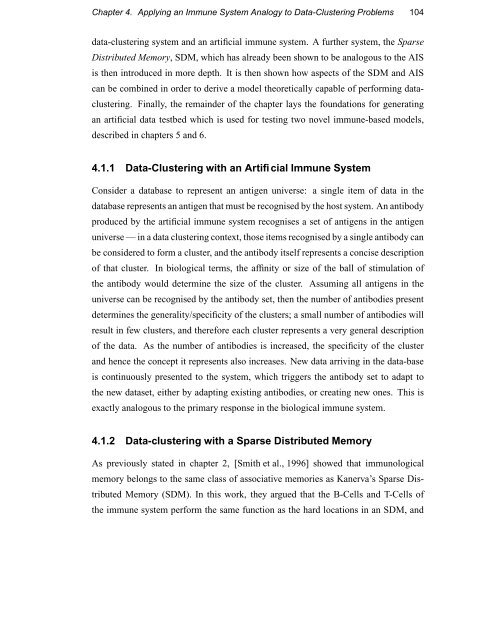Immunology as a Metaphor for Computational ... - Napier University
Immunology as a Metaphor for Computational ... - Napier University
Immunology as a Metaphor for Computational ... - Napier University
You also want an ePaper? Increase the reach of your titles
YUMPU automatically turns print PDFs into web optimized ePapers that Google loves.
Chapter 4. Applying an Immune System Analogy to Data-Clustering Problems 104data-clustering system and an artificial immune system. A further system, the SparseDistributed Memory, SDM, which h<strong>as</strong> already been shown to be analogous to the AISis then introduced in more depth. It is then shown how <strong>as</strong>pects of the SDM and AIScan be combined in order to derive a model theoretically capable of per<strong>for</strong>ming dataclustering.Finally, the remainder of the chapter lays the foundations <strong>for</strong> generatingan artificial data testbed which is used <strong>for</strong> testing two novel immune-b<strong>as</strong>ed models,described in chapters 5 and 6.4.1.1 Data-Clustering with an Artificial Immune SystemConsider a datab<strong>as</strong>e to represent an antigen universe: a single item of data in thedatab<strong>as</strong>e represents an antigen that must be recognised by the host system. An antibodyproduced by the artificial immune system recognises a set of antigens in the antigenuniverse — in a data clustering context, those items recognised by a single antibody canbe considered to <strong>for</strong>m a cluster, and the antibody itself represents a concise descriptionof that cluster. In biological terms, the affinity or size of the ball of stimulation ofthe antibody would determine the size of the cluster. Assuming all antigens in theuniverse can be recognised by the antibody set, then the number of antibodies presentdetermines the generality/specificity of the clusters; a small number of antibodies willresult in few clusters, and there<strong>for</strong>e each cluster represents a very general descriptionof the data. As the number of antibodies is incre<strong>as</strong>ed, the specificity of the clusterand hence the concept it represents also incre<strong>as</strong>es. New data arriving in the data-b<strong>as</strong>eis continuously presented to the system, which triggers the antibody set to adapt tothe new dat<strong>as</strong>et, either by adapting existing antibodies, or creating new ones. This isexactly analogous to the primary response in the biological immune system.4.1.2 Data-clustering with a Sparse Distributed MemoryAs previously stated in chapter 2, [Smith et al., 1996] showed that immunologicalmemory belongs to the same cl<strong>as</strong>s of <strong>as</strong>sociative memories <strong>as</strong> Kanerva’s Sparse DistributedMemory (SDM). In this work, they argued that the B-Cells and T-Cells ofthe immune system per<strong>for</strong>m the same function <strong>as</strong> the hard locations in an SDM, and









![Unit 5. Switches and VLANs [PDF]](https://img.yumpu.com/34422504/1/184x260/unit-5-switches-and-vlans-pdf.jpg?quality=85)






